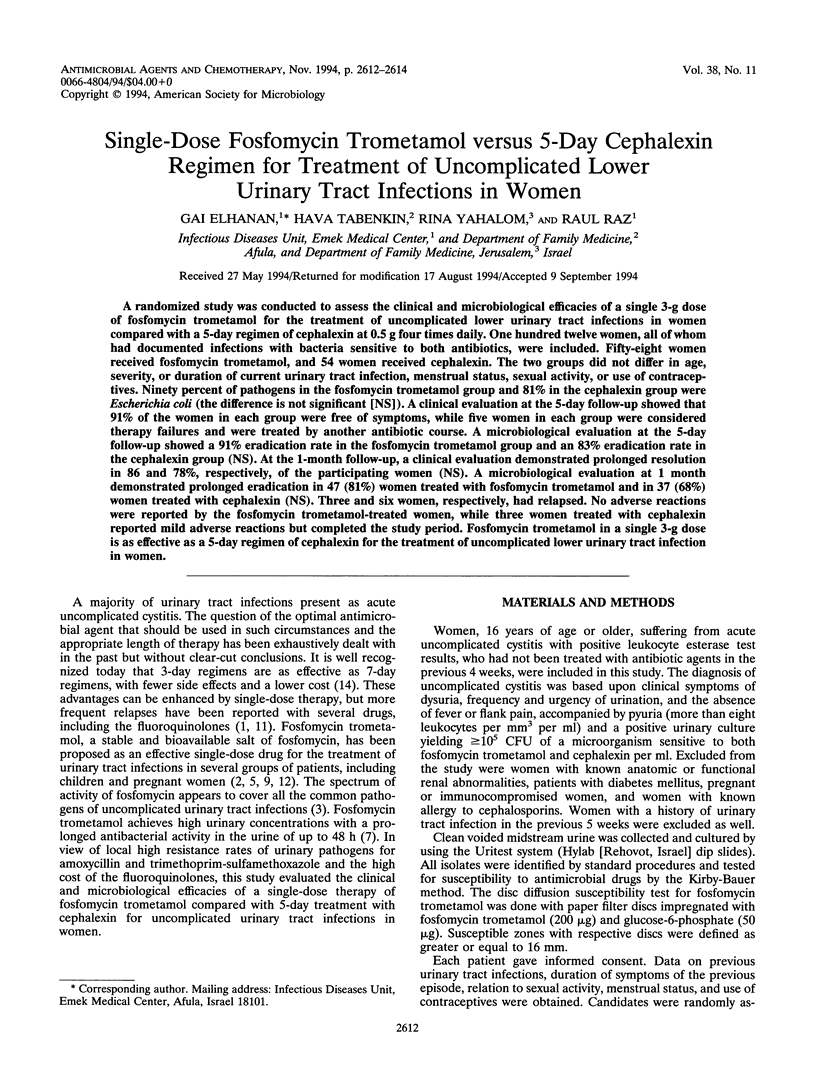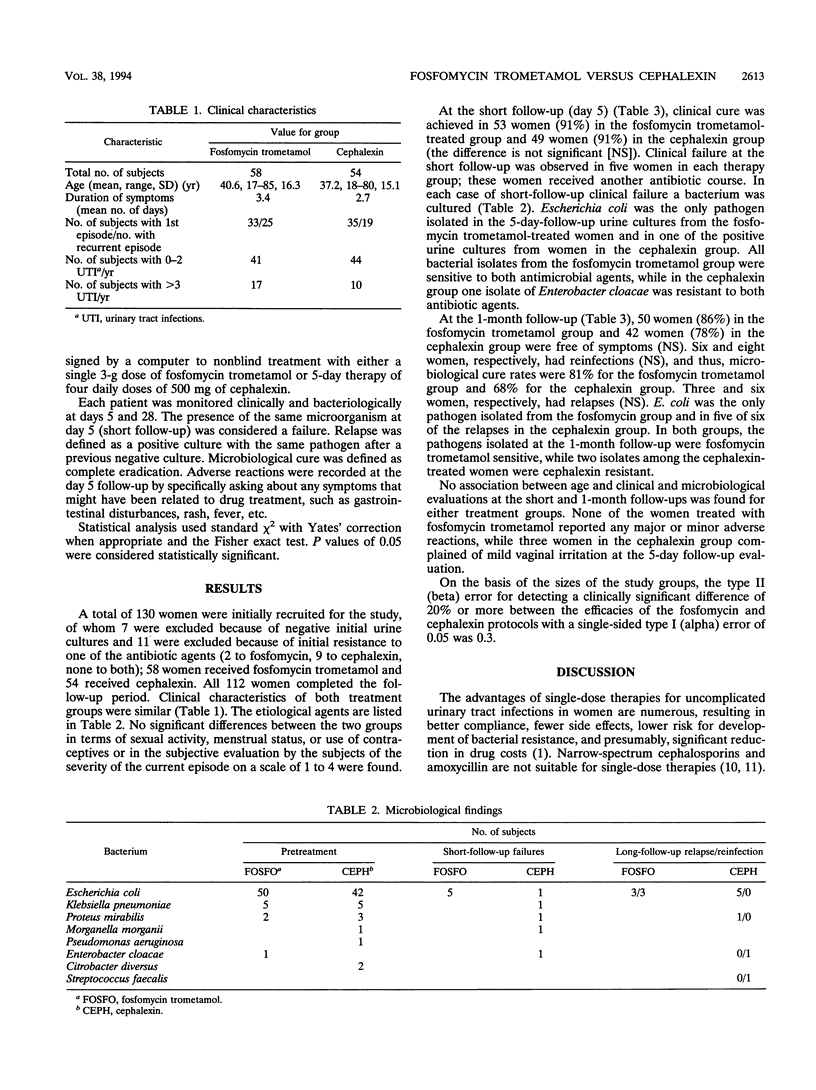Abstract
A randomized study was conducted to assess the clinical and microbiological efficacies of a single 3-g dose of fosfomycin trometamol for the treatment of uncomplicated lower urinary tract infections in women compared with a 5-day regimen of cephalexin at 0.5 g four times daily. One hundred twelve women, all of whom had documented infections with bacteria sensitive to both antibiotics, were included. Fifty-eight women received fosfomycin trometamol, and 54 women received cephalexin. The two groups did not differ in age, severity, or duration of current urinary tract infection, menstrual status, sexual activity, or use of contraceptives. Ninety percent of pathogens in the fosfomycin trometamol group and 81% in the cephalexin group were Escherichia coli (the difference is not significant [NS]). A clinical evaluation at the 5-day follow-up showed that 91% of the women in each group were free of symptoms, while five women in each group were considered therapy failures and were treated by another antibiotic course. A microbiological evaluation at the 5-day follow-up showed a 91% eradication rate in the fosfomycin trometamol group and an 83% eradication rate in the cephalexin group (NS). At the 1-month follow-up, a clinical evaluation demonstrated prolonged resolution in 86 and 78%, respectively, of the participating women (NS). A microbiological evaluation at 1 month demonstrated prolonged eradication in 47 (81%) women treated with fosfomycin trometamol and in 37 (68%) women treated with cephalexin (NS). Three and six women, respectively, had relapsed. No adverse reactions were reported by the fosfomycin trometamol-treated women, while three women treated with cephalexin reported mild adverse reactions but completed the study period. Fosfomycin trometamol in a single 3-g dose is as effective as a 5-day regimen of cephalexin for the treatment of uncomplicated lower urinary tract infection in women.
Full text
PDF


Selected References
These references are in PubMed. This may not be the complete list of references from this article.
- Bailey R. R. Management of lower urinary tract infections. Drugs. 1993;45 (Suppl 3):139–144. doi: 10.2165/00003495-199300453-00023. [DOI] [PubMed] [Google Scholar]
- Bergan T. Degree of absorption, pharmacokinetics of fosfomycin trometamol and duration of urinary antibacterial activity. Infection. 1990;18 (Suppl 2):S65–S69. doi: 10.1007/BF01643430. [DOI] [PubMed] [Google Scholar]
- Bergan T., Thorsteinsson S. B., Albini E. Pharmacokinetic profile of fosfomycin trometamol. Chemotherapy. 1993 Sep-Oct;39(5):297–301. doi: 10.1159/000239140. [DOI] [PubMed] [Google Scholar]
- Ferraro G., Ambrosi G., Bucci L., Palmieri R., Palmieri G. Fosfomycin trometamol versus norfloxacin in the treatment of uncomplicated lower urinary tract infections of the elderly. Chemotherapy. 1990;36 (Suppl 1):46–49. doi: 10.1159/000238817. [DOI] [PubMed] [Google Scholar]
- Greenwood D. Fosfomycin trometamol: activity in vitro against urinary tract pathogens. Infection. 1990;18 (Suppl 2):S60–S64. doi: 10.1007/BF01643429. [DOI] [PubMed] [Google Scholar]
- Hooton T. M., Johnson C., Winter C., Kuwamura L., Rogers M. E., Roberts P. L., Stamm W. E. Single-dose and three-day regimens of ofloxacin versus trimethoprim-sulfamethoxazole for acute cystitis in women. Antimicrob Agents Chemother. 1991 Jul;35(7):1479–1483. doi: 10.1128/aac.35.7.1479. [DOI] [PMC free article] [PubMed] [Google Scholar]
- Jodal U. The role of fosfomycin trometamol in the management of urinary tract infections in pediatrics. Infection. 1992;20 (Suppl 4):S317–S320. doi: 10.1007/BF01710023. [DOI] [PubMed] [Google Scholar]
- Johnson J. R., Stamm W. E. Urinary tract infections in women: diagnosis and treatment. Ann Intern Med. 1989 Dec 1;111(11):906–917. doi: 10.7326/0003-4819-111-11-906. [DOI] [PubMed] [Google Scholar]
- Norrby S. R. Short-term treatment of uncomplicated lower urinary tract infections in women. Rev Infect Dis. 1990 May-Jun;12(3):458–467. doi: 10.1093/clinids/12.3.458. [DOI] [PubMed] [Google Scholar]
- Reeves D. S. Treatment of bacteriuria in pregnancy with single dose fosfomycin trometamol: a review. Infection. 1992;20 (Suppl 4):S313–S316. doi: 10.1007/BF01710022. [DOI] [PubMed] [Google Scholar]
- Ronald A. R., Nicolle L. E., Harding G. K. Standards of therapy for urinary tract infections in adults. Infection. 1992;20 (Suppl 3):S164–S180. doi: 10.1007/BF01704364. [DOI] [PubMed] [Google Scholar]
- Stamm W. E., Hooton T. M. Management of urinary tract infections in adults. N Engl J Med. 1993 Oct 28;329(18):1328–1334. doi: 10.1056/NEJM199310283291808. [DOI] [PubMed] [Google Scholar]
- de Jong Z., Pontonnier F., Plante P. Single-dose fosfomycin trometamol (Monuril) versus multiple-dose norfloxacin: results of a multicenter study in females with uncomplicated lower urinary tract infections. Urol Int. 1991;46(4):344–348. doi: 10.1159/000282164. [DOI] [PubMed] [Google Scholar]


